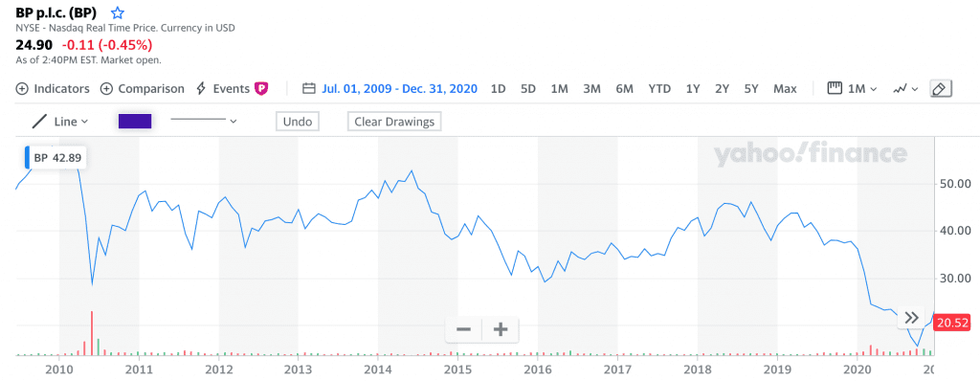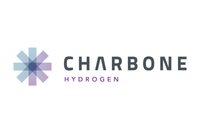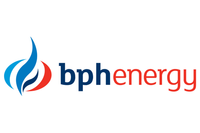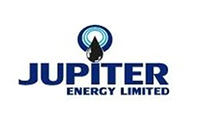What Was the BP Stock Price Before the Deepwater Horizon Spill?
The BP stock price has dropped due to the crash in oil prices, but that isn’t the only negative catalyst in the company’s history.
The oil price has tumbled since 2014, crashing from over US$100 per barrel down to as low as US$19 in April 2020 at the peak of the first wave of the coronavirus pandemic.
Major oil producers have all had to adapt to the new economic realities created by the price collapse, but BP (NYSE:BP,LSE:BP) is in an especially challenging position. That’s because the albatross of the Deepwater Horizon oil spill still hangs about its corporate neck.
The oil giant suffered heavy fines and an even heavier blow to its global reputation following the 2010 spill in the Gulf of Mexico. Since then, BP has spent about US$70 billion in federal fines and lawsuit payouts to Gulf Coast businesses and residents. With the spill now a decade in the past, what should investors know about this catastrophic event and what could be next for BP? Read on to find out.
Deepwater Horizon spill impact on BP stock
The Deepwater Horizon spill, considered the worst of oil spill in US history, released an estimated 3.19 million barrels of oil into the Gulf Coast over the course of 87 days before the leaking pipe was finally capped. In addition to about US$14 in lawsuit settlements and a US$4 billion fine levied by the US Department of Justice, BP has reportedly paid US$20 billion to settle suits brought by state governments and the federal government, as well as US$32 billion to clean up the oil spill.
Prior to the incident, BP’s stock price was sitting at roughly US$59. Not surprisingly, the spill coincided with one of the biggest drops for the BP stock price since 1978. The company’s share price lost 54 percent on the NYSE between April 20, 2010, and June 25, 2010, bouncing back slightly before the wellhead was capped on July 15, 2010. BP stock lost a similar amount in London over the same period.
Previously, the company had lost roughly 45 percent of its share price value in New York between May 23, 2008, and October 10, 2008 — that fall came during the global financial crisis.
The selloff in the wake of the Deepwater Horizon spill was also marked by the largest trading volumes in BP stock price history by a long shot. Volumes peaked at 735.76 million in New York on June 11, 2010, compared with daily averages of closer to 30 million. Check out the trading volume spike at the bottom left of the BP stock price chart below:
BP stock price, July 1, 2009, to December 31, 2020. Chart via Yahoo Finance.
Road to recovery paved in green energy?
Since the 2010 spill, BP has made efforts to move forward and adapt to the new lower oil price environment by cutting costs to reduce its breakeven point.
Along with lower costs, an increase in the company’s credit rating alongside improved production have helped the oil giant down a path to recovery as it seeks to keep up with its competitors, such as ExxonMobil (NYSE:XOM) and Chevron (NYSE:CVX).
Throughout 2018 and most of 2019, BP’s share price was trading above the US$40 range in New York, reaching as high as US$47 in June 2018. The situation began to change in 2020. In January, prior to the start of global coronavirus lockdowns, shares of BP were trading at nearly US$39. But by March, oil prices had nosedived from over US$52 to barely above US$19 as the virus took hold globally. BP’s share price followed oil down to trade at the US$17 level — a point not seen since 1994.
BP’s financials for Q3 2020 did offer investors some hope, as the company eked out a US$86 million profit after a US$16.8 billion loss in the second quarter. By comparison, in Q3 2019, BP reported US$2.3 billion in profits. BP CEO Bernard Looney told investors at the time that their dividend remained safe. As of December 31, 2020, shares of BP were trading at US$20.52 on the NYSE.
The impact of the COVID-19 crisis on global oil markets has strengthened BP’s resolve to transition to more renewable energy projects. According to a report by the Guardian, “BP plans to reduce production of oil and gas by 40% over the next decade while investing billions in renewable energy to transform it from oil major to modern energy company.”
Case in point — in September 2020, BP waded into the offshore wind market with a $1.1 billion stake in two US offshore wind projects being developed by the Norwegian state oil company Equinor. Then, in November 2020, the oil company announced its intention to partner with Danish green energy entity Orsted on the development of a large-scale renewable hydrogen project in Germany.
Oil market outlook post-COVID
Near the end of 2020, positive COVID-19 vaccine news from pharmaceutical companies Pfizer (NYSE:PFE), Moderna (NASDAQ:MRNA) and AstraZeneca (NYSE:AZN) proved beneficial for oil prices.
But the oil price rally may not enough to encourage more investment in new production.
According to the World Bank, US oil production fell by one-fifth in May 2020 alongside demand and prices. By October 2020, the country’s output remained around 10 percent below its 2019 level. New drilling activity for the first seven months of the year fell by 75 percent to an all-time low in August 2020.
“Survey results from the Federal Reserve Bank of Dallas suggest most U.S. shale companies do not expect a major increase in new drilling until the price of WTI increases above $50/bbl—$10/bbl above its current level,” said Peter Nagle, an economist with the World Bank’s Development Prospects Group. Given the weak investment, average oil production in the US, the world’s leading oil producer, is expected to be nearly 3 percent lower in 2021 compared to 2020.
For its part, the Organization of the Petroleum Exporting Countries, better known as OPEC, and its partners have cut oil production by almost 10 percent of global supply.
In terms of consumption, the COVID-19 pandemic is expected to impact demand well into 2021. In fact, the World Bank doesn’t expect demand to make a full recovery until 2023. One of the “bright spots” in the oil market, according to World Oil, is diesel, used for shipping and freight transport, which has benefited from rising demand for online shopping during the COVID-19 pandemic.
For now, it seems BP and other oil companies will continue to face a challenging environment moving forward, and may react by expanding their green energy interests.
This is an updated version of an article first published by the Investing News Network in 2016.
Don’t forget to follow us @INN_Resource for real-time updates!
Securities Disclosure: I, Melissa Pistilli, hold no direct investment interest in any of the companies mentioned in this article.
- Top 10 Oil-producing Countries | INN ›
- 5 Top US Oil and Gas Dividend Stocks | INN ›
- 5 Top Canadian Oil and Gas Dividend Stocks | INN ›
- Top Oil and Gas Stocks on the TSX and TSXV | INN ›
- Ways to Invest in Oil ›






